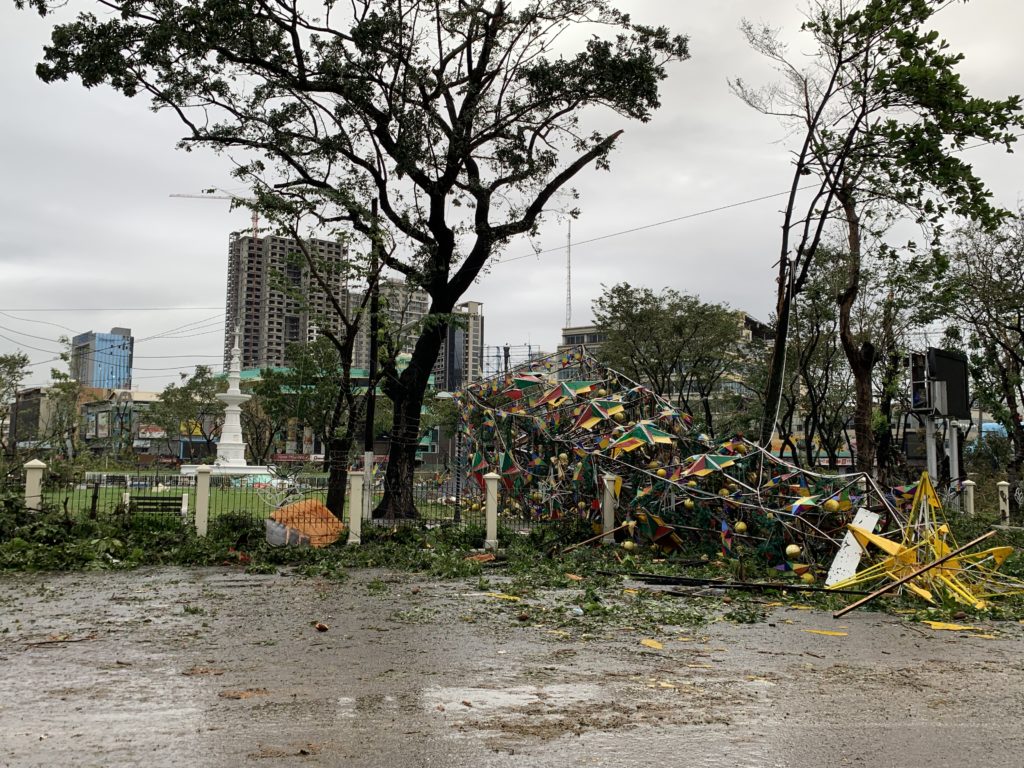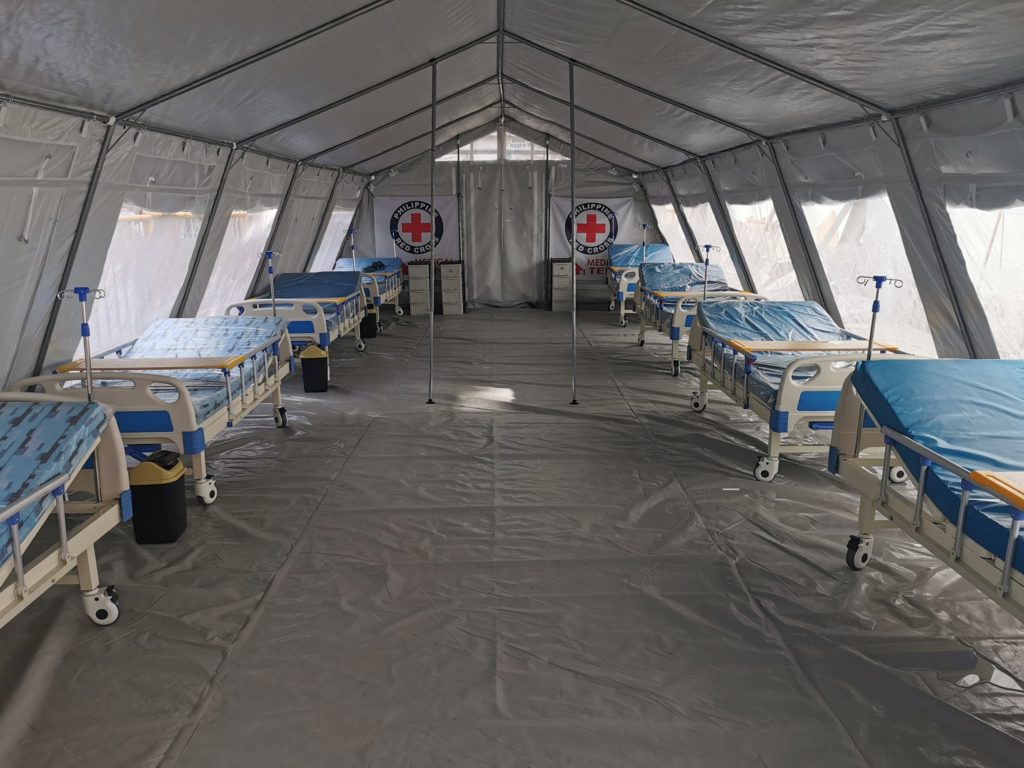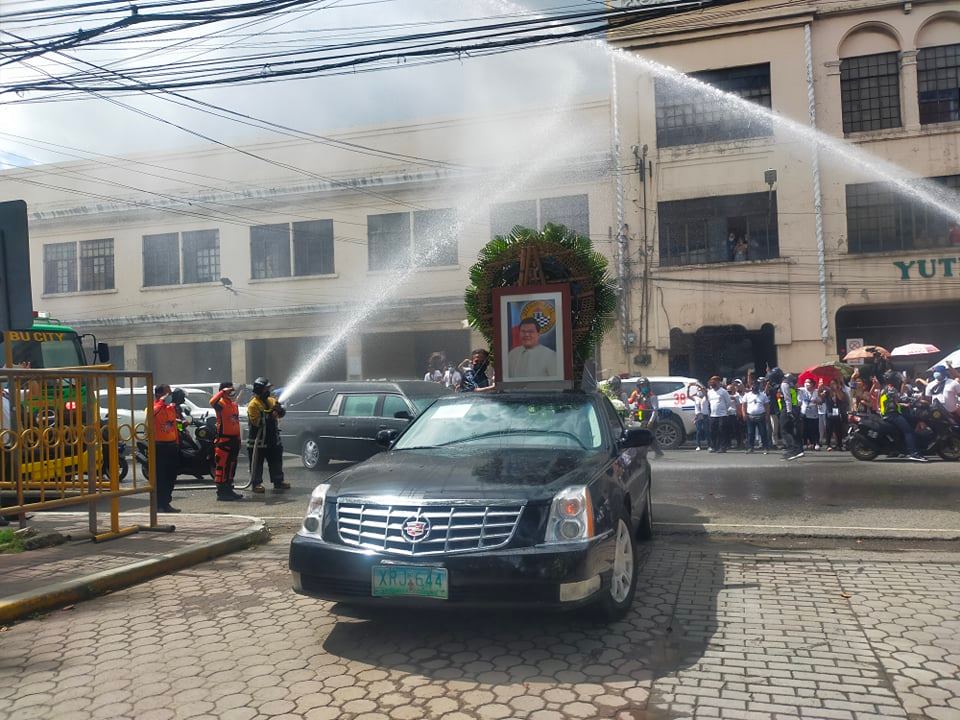This is the first part of a 2-part year-ender report by CDN Digital
CEBU CITY, Philippines – First, it was the pandemic. Now, Albelyn Bravo had to make sure their family has enough water to get them through the day.
As early as 6 a.m., the mother of four from Brgy. Kamputhaw would join a long line along Escario Street to fill six four-gallon containers with water for bathing, washing their dishes, and flushing their toilets.
This has been her daily routine since Typhoon Odette (international name: Rai) struck Cebu last December 16, 2021, just nine days before Christmas Day.
The typhoon’s aftermath left majority of central and southern Cebu, including Metro Cebu, in a state of blackout the following day.
No electricity, telecommunications were down, and there was no running water, prompting families like the Bravos to seek establishments giving out free, clean water.
As soon as she returns home, Albelyn would carefully ration the water she just got. Their family would reuse the water used in bathing and washing their dishes to flush their toilets, and to some extent, water their plants.
“Tipid gyud kaayo,” she remarked.
(We really have to be mindful of how we use our water.)
Albelyn’s experience marks how most of Cebu celebrated Christmas, and how they will be welcoming the New Year.
They were fortunate enough to get spared from the raging COVID-19 pandemic but they were not able to escape Odette’s wrath. But for the 34-year-old mother, the most important thing was that they all survived.
“Lisud sad tong pandemic pero kani (Odette’s aftermath), back to zero. Back to scratch gyud… Igo nalang mi mag ayum-ayum sa among atop. Wa mi mahimo. Gigusbat man gyud among atop. Wa say kapalitan kay hurot-hurot nasad ang supply. Puro nangabasa (among gamit). Among ref (fridge), TV. Way nahibilin. Basa tanan. Ang mga sanina, amo nalang gipabuwad sa init,” Albelyn recounted.
(The pandemic was also but this, we’re back to zero. Really back to scratch. We can only do what’s left of our roof. We have no choice. The typhoon really crumpled our roof. We also don’t know where to buy since stocks are already running out. All of our things got wet. Our fridge, TV. Nothing was spared. All of them were wet. Our clothes that got soaked, we sun-dried them.)
“Pero bahala na na tanan. Ang gisiguro nako ang anak oy. Di na nako problema run (nga wa sa mi gamit). Basta importante buhi. Makakita ra man ta ug kwarta, mabalik ra man na ang gamit pero ang kinabuhi, di na,” she continued.
(But never mind our wet things. I made sure all my children are safe. That’s no longer my problem. The important thing is that we’re alive. We can still earn some money. We can get our things back but our lives, you cannot get them back.)
The Wake of Odette

The giant Christmas tree at the Fuente Rotunda in uptown Cebu City is simply no match for the wrath of super typhoon Odette. The strongest typhoon to hit Cebu in years has also left 13 people dead as of the last count. CDN Digital photo | Brian Ochoa
Odette claimed the lives of at least 96 people in Cebu. Most of the fatalities died after being crushed by heavy objects such as uprooted trees, concrete slabs of weak structures, and roof beams.
The typhoon unleashed winds with speeds up to 195 kilometers per hour (kph), with gustiness – which refers to a wind’s peak speed – reaching up to 220 kph, when it made landfall in Carcar City on the evening of December 16.
People in Cebu woke up the next day, December 17, to a massive trail of destruction. Trees snapped into two, houses knocked over, toppled electricity and telecommunication posts, no running water, and most roads impassable.
In the following days, the Odette-induced crisis would manifest in various ways. People lining before functioning automated teller machines (ATMs) to withdraw cash; and more campaign overnight along highways and other roads to queue for fuel and water.
Many described Odette, the strongest typhoon to hit the Philippines this 2021, to have almost reached the levels of Super Typhoon Yolanda. Some even observed that its trail of destruction is similar to that of Yolanda in 2013.
Yolanda was considered the deadliest typhoon to slam the country, with over 5,000 lives wasted, and billions of infrastructure and agriculture damaged in the Visayas, particularly in the Eastern region.
Others also compared Odette’s strength with that of Typhoon Ruping in 1990, believed to be the deadliest major weather disturbance to strike Cebu until the former barreled its way through the island last December 16. Odette followed almost the same path with that of Ruping.
As of 8 a.m. on December 30, the National Disaster Risk Reduction and Management Council (NDRRMC), the state’s disaster-response head unit, reported that damage in agriculture and infrastructure in Central Visayas already reached a total of P2,773,141,700.
But these figures are expected to grow as other sectors and industries report the damages they incurred during Odette’s onslaught.
The Business Process Outsourcing (BPO) industry in Cebu alone stated on December 21 that they already lost P5 billion in revenues due to unrestored power and communication lines.
As of December 30, Visayan Electric, Metro Cebu’s energy distributor, has managed to restore electricity along major thoroughfares and critical areas here – from hospitals to primary business districts, including areas where BPO firms are located.
READ MORE: Visayan Electric: National highway from Liloan to San Fernando now reenergized
In the province, where tourism players abound, the provincial government, through its Tourism Office (PTO), initially pegged the damages Odette caused at P20 million, as of December 28.
While pork supply remains stable, the Central Visayas Pork Producers Cooperative (CeViPPCo) reported that commercial farms producing pork and exporting live hogs in the region incurred damages up to P257 million.
READ MORE: Cebu still has enough pork supply for next three months–CeViPPCo
READ MORE: #OdettePH: Damage in Cebu province’s tourism industry initially pegged at P20M
2021: Double Whammy

A man loads up an oxygen tank to a cab in Cebu City. Oxygen tanks are selling like hotcakes as COVID-19 patients continue to line up in hospitals here. CDN Digital photo | Morexette Marie B. Erram
Like Albelyn, a taxi driver from Compostela town, who requested anonymity, experienced Odette’s fury. His house lost its roofing, the only thing that would shield him from nature’s harsh elements.
“Mahal pa sad kaayo ipalit run kay daghan kaayo nangita. Mahal na gani daan ang sin,” he pointed out.
(It’s too expensive to buy them right now because of the high demand. G.I. sheets are already costly in the first place.)
But unlike Albelyn, the recent natural disaster was a double-whammy to him. The ongoing COVID-19 pandemic has already left him reeling.
In November, when Cebu’s COVID outbreak improved and restrictions began to relax, the taxi driver said he was glad to see and feel small signs of normalcy. However, his hopes were short-lived.
Days after Odette passed, he continues to drive around Metro Cebu. When CDN Digital interviewed him, he expressed concern over long queues of vehicles wanting to be refueled in nearby gasoline stations.
The taxi driver even contemplated going as far as Bogo City in north Cebu if it meant securing fuel for his vehicle, and ultimately making sure that he can still continue on with his only means of livelihood.
“Grabe ka paet bitaw ma’am. Kung naay ayuda ihatag, mas maayo kung ihatag dayun,” he added.
(It’s really hard. If they can provide aid, it’s better if they can distribute them as soon as possible.)
Indeed, 2021 was not an easy year for ordinary Cebuanos like Albelyn and the taxi driver from Compostela.
‘Worst Surge’

An air-conditioned medical tent from the Philippine Red Cross was delivered to Cebu City on Sunday, August 15, 2021, to help address issues arising from the continued increase of COVID-19 cases here. | Photos from Cebu City Councilor Dave Tumulak
Even before Odette arrived, Cebu faced an equally devastating crisis this year.
Last July, up to September, the island province faced its worst surge of COVID-19 infections. The ‘third wave’ was driven by the feared Delta variant, touted to be deadlier than the original strain of the SARS-CoV-2, the virus that causes the infection.
Cebu recorded a total of 24,856 additional COVID patients within a span of one month only, from August 1 to August 31. These figures illustrate just how fast the Delta variant spreads.
In comparison, the entire Cebu only managed to breach the 24,000-mark in total confirmed cases sometime in January this year, or after 11 months since the first case was detected here.
Even more worrisome were the deaths with 1,140 mortalities related to the infection reported during the same period.
As a result, the entire Cebu was reverted to stricter quarantine restrictions, shuttering businesses once again that were barely surviving since the pandemic began, reviving the uncertainties experienced in 2020.
It was only in September when the entire island province began to gradually ease its heightened health protocols.
READ MORE: How fast Delta spreads? In Cebu, 24k new cases in 1 month | CDN Digital (inquirer.net)
Leaders We Lost

The arrival of the hearse carrying the remains of Mayor Edgardo Labella at the City Hall on Wednesday, November 24, 2021. CDN Digital photo | Delta Letigio
In 2021, Cebu also lost and mourned leaders who departed.
Cebu City Mayor Edgardo Labella died last November 19. His cause of death was ruled as ‘septic shock secondary to pneumonia’. Labella passed away a month after he filed for another medical leave due to pneumonia.
He was 70 years old.
Labella was elected as mayor during the 2019 elections, winning against then-incumbent Mayor Tomas Osmeña. Before he served as local chief executive, he served two terms as the city’s vice mayor, from 2013 to 2019.
The late mayor’s political career began in 1998 when he ran and won as a councilor for Cebu City’s North District. Back then, he was allied with Osmeña under the Bando-Osmeña Pundok Kauswagan (BOPK).
Labella shifted political alliances in 2012. He joined several councilors in backing present Cebu City Mayor Michael Rama’s mayoralty bid against Osmeña under Team Rama (now called Partido Barug).
Before Labella entered politics, he served as the director for the Ombudsman in the Visayas from 1994 to 1998.
Cebu also bid goodbye to two members of the Osmeña clan – former Senator John Henry ‘Sonny’ Osmeña and former governor Emilio Mario “Lito” Osmeña.
Sonny passed away on February 4 after succumbing to colon cancer. He was 86.
The grandson of former President Sergio Osmeña Sr., Sonny had a colorful life as a politician. His last stint was as mayor of Toledo City.
Until his death, Sonny was the last surviving pre-Martial Law Senator.
Roughly five months later. Sonny’s cousin, Lito, died on July 19 due to complications from COVID-19.
Although he did not coin the term ‘CeBoom’, which refers to the age when Cebu province experienced rapid economic development, Lito was credited as the ‘architect’ behind it.
During his term as governor, from 1988 to 1992, the Capitol was able to push and complete multiple infrastructural projects including the Transcentral Highway, modernization of the Cebu International Airport (now named Mactan-Cebu International Airport), concreting provincial roads, expanding telecommunications network in the province, to name some.
In pure politics, Lito was also known for rebranding the word promdi, a colloquial term associated with individuals residing in a city and hailed from the province.
He founded the Progressive Movement for the Devolution of Initiatives (PROMDI), a local political party in Cebu. Presently, Promdi is fielding Senator Manny Pacquiao as its presidential candidate.
Another former governor also passed on, just a month after Lito’s death.
Former governor Pablo ‘Pabling’ Garcia died on August 18. Garcia was the governor of Cebu from 1995 to 2004, completing three terms. He was succeeded by his daughter, incumbent Governor Gwendolyn Garcia.
During his administration, Cebu became the wealthiest province in the country, the result of his efforts in ensuring that the province would be financially stable. Until today, Cebu remains the richest province in the Philippines, with net assets totaling up to P208 billion.
2021 is definitely rife with challenges and crises that test every Cebuano’s character and patience. But like the saying goes, ‘this storm shall pass’.
/bmjo
To be continued …

